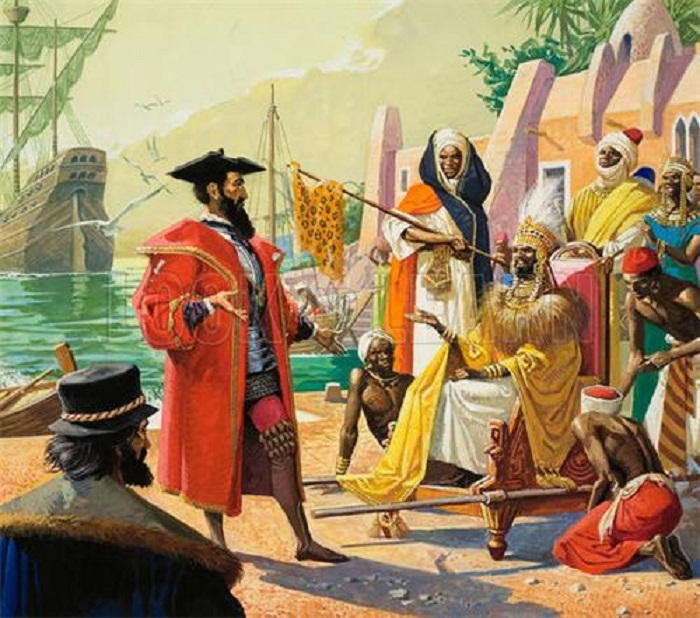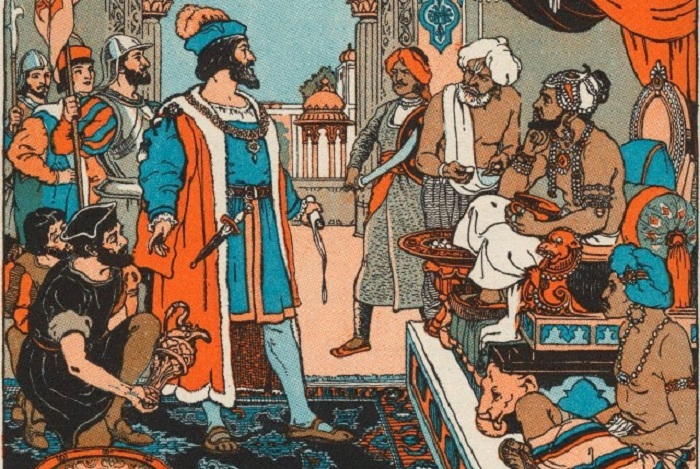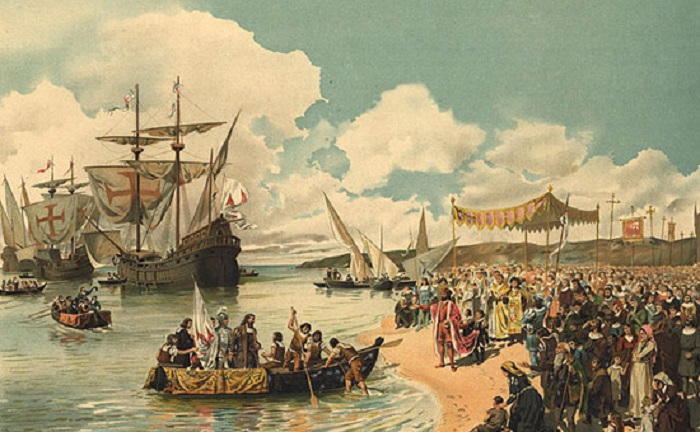Fast Facts
Portuguese Presence in India: 1505 – 1961
Portuguese East India Company: 1628 – 1633
Portuguese Capitals in India: Cochin (1505 – 1530), Old Goa (1530 – 1843), Nova Goa (1843 – 1961)
Political Structure: Colony
Portuguese Viceroys in India
- 1505–1509 Francisco de Almeida (first)
- 1896 Afonso, Duke of Porto (last)
Portuguese Governor-generals in India
- 1509–1515 Afonso de Albuquerque (first)
- 1958–1961 Manuel António Vassalo e Silva (last)

Image Credit : http://www.indiaonline.in/about/profile/history/indian-history/modern-age/colonial-era
Many Europeans, including the seagoing voyagers of Portugal, were looking for a sea route to the Indian Subcontinent during the 14th century. The task was eventually accomplished by Vasco da Gama, who reached Calicut on May 20, 1498. Six years later, Portuguese State of India (Estado Português da Índia, EPI) or simply Portuguese India (Índia Portuguesa) was founded to serve as the governing body of fortresses and colonies that were established overseas by the Portuguese. In 1505, Francisco de Almeida was appointed as the first Viceroy, with his headquarters in Cochin. Over the years, the Portuguese managed to expand their presence in the Indian Subcontinent by setting up colonies in the Indian Ocean. By mid-19th century, the Portuguese control was confined to the colonial holdings on the Malabar Coast. During India’s independence from the British, Portuguese India was divided into three districts. By December 1961, Portugal had lost control over most of its overseas territory, including Portuguese India.
History of the Portuguese in India
The history of the Portuguese in India is heavily influenced by the Portuguese sailors and officials, who set foot in India with an aim of setting up trading centers in the country. These sailors and officials not just established Portuguese settlements in India, but also became pioneers by showing to the fellow Europeans the much sought after sea route to India. Some of the prominent Portuguese officials who were associated with the arrival, establishment and governance of the Portuguese rule in India are mentioned below:
Vasco da Gama – On May 20, 1498, Vasco da Gama arrived in India and became the first European sailor to reach India by sea. Vasco da Gama’s discovery is considered extremely important as it unlocked new trading options for not only the Portuguese but for other Europeans as well. Upon Da Gama’s arrival, Zamorin, the King of Calicut, returned to Calicut from his second capital at Ponnani to receive the foreign fleets. When Vasco da Gama sent his presents to Zamorin, the King of Calicut was not impressed by the gifts due to the absence of gold and silver. When Zamorin demanded Vasco da Gama to pay customs duty in gold like any other foreign trader, relations between Zamorin and Vasco Da Gama strained. In response, an irate Da Gama took along with him a few Calicut citizens and sixteen fishermen by force. When Vasco Da Gama returned to Portugal, he carried with him a cargo filled with Indian spices and other riches that was worth sixty times the cost of Da Gama’s Indian expedition.
Pedro Alvares Cabral – In 1500, another expedition was sent to India under the command of a Portuguese nobleman and military commander named Pedro Alvares Cabral. The objective of this expedition was to enter a treaty with Zamorin of Calicut and to set up a factory in Calicut. Thanks to his negotiation skills, Cabral was able to obtain Zamorin’s permission to set up factory and a warehouse in Calicut. At the time when Cabral was seeking ways to strengthen his bond with the King of Calicut, the Portuguese factory was attacked by local Hindus and Muslim Arabs. The surprise attack resulted in the death of more than 50 Portuguese. Assuming that the attack was the handiwork of some jealous Arab merchants, Pedro Alvares Cabral waited for Zamorin’s explanation, but to no avail. Angered by the attack and by Zamorin’s silence, Cabral ordered the seizure of ten anchored Arab merchant ships. He also killed 600 of their crew members and burnt down the ships after confiscating its cargoes. Cabral was also successful in entering into advantageous treaties with rulers of Cochin and Kannur (Cannanore).

Image Credit : https://navrangindia.blogspot.com/2014/11/portuguese-landing-in-india-1498.html
Francisco de Almeida – Dom Francisco de Almeida was chosen as the first Viceroy of Portuguese India on March 25, 1505. Since Vasco da Gama had failed to bring the King of Calicut to submission, King Dom Manuel I decided to give Almeida the responsibility of handling Zamorin. Almeida was instructed to build four forts at Cochin, Kannur, Anjediva Island, and Kollam (Quilon). Hence, Almeida left for India with a fleet of 22 vessels that carried 1500 men. Upon reaching Anjediva Island on 13 September, Almeida started constructing ‘Fort Anjediva.’ He then reached Kannur, where he sought the permission of the ruler of Kannur to build ‘St. Angelo Fort.’ He commenced the construction of ‘St. Angelo Fort’ on October 23. After leaving Lourenco de Brito in charge of constructing the fort, Francisco de Almeida left for Cochin. He reached Cochin on October 31, where he was informed about the killing of Portuguese traders at Kollam. Outraged by the attack, Almeida sent his son Lourenco de Almeida, who destroyed 27 vessels in the harbor of Kollam. Almeida further succeeded by strengthening Portuguese fortifications at Cochin.
Lourenco de Almeida – In 1505, Lourenco became the first Portuguese to travel to Ceylon in order to establish a Portuguese settlement in Ceylon, on his father Francisco de Almeida’s command. In Calicut, when King Zamorin called for a fleet of 200 ships to challenge the Portuguese, Lourenco obstructed Zamorin’s fleet at the entrance of the Kannur harbor. This led to the ‘Battle of Cannanore’ in 1506, which Lourenco won comprehensively, handing Zamorin’s fleet a heavy defeat. Lourenco then continued exploring the coastal waters, travelling all the way to Colombo. Meanwhile, Zamorin convinced the ruler of Kannur to join him in his fight against the Portuguese. With the help of the Arabs, the Zamorin and the King of Kannur managed to besiege ‘Fort St. Angelo’ for four months, which later came to be known as the ‘Siege of Cannanore.’ The siege left many Portuguese without food, and forced them to surrender. However, the timely arrival of Tristao da Cunha’s squadron in 1507 strengthened Almeida’s mission. In March 1508, the Arab merchants of Calicut invoked the Egyptians, who sent a fleet under Amir Husain Al-Kurdi’s command. The Egyptian fleet attacked the Portuguese squadron led by Lourenco de Almeida, which resulted in the ‘Battle of Chaul.’ The Portuguese were defeated in the battle, and Lourenco de Almeida too was killed.
Afonso de Albuquerque – In 1509, Albuquerque was chosen as the second governor of the Portuguese possessions in India. He sent a fleet commanded by Marshal Fernao Coutinho in order to take over Calicut from Zamorin. Zamorin’s palace was subsequently destroyed and the city of Calicut was set on fire. When Zamorin’s forces retaliated, Albuquerque entered into a treaty with Zamorin in 1513. Meanwhile, Albuquerque managed to defeat the Sultans of Bijapur, and established a prominent Portuguese settlement in Velha Goa (Old Goa). Goa would go on to become an important trade center for the Portuguese.
Duarte Pacheco Pereira – In 1503, Pacheco Pereira served as the captain of one of the three ships headed by Afonso de Albuquerque. In the following year, Pereira was tasked with the responsibility of defending Cochin from Zamorin’s attacks. With only 150 Portuguese and a handful of Malabarese auxiliaries, Pereira’s army was outnumbered by Zamorin’s army of 60,000 men. However, Pereira was successful in resisting Zamorin’s attacks for five months, which humiliated Zamorin, who finally recalled his forces. Pereira’s smartness and courage greatly impressed the Trimumpara Raja of Cochin, who honored him with a grant of arms.
Lopo Vaz de Sampaio – In 1526, Lopo Vaz de Sampaio was made the sixth Governor of the ‘State of India.’ Under Sampaio’s command, the Portuguese took over territories of Mangalore. A couple of years later, an army under the command of Sampaio attacked the Gujarat Sultanate and seized the fort of Mahim. Lopo Vaz de Sampaio had earlier served as Vasco da Gama’s captain in one of his ships. He was later arrested in one of the battles and was sent back to Portugal as a prisoner.
Manuel Antonio Vassalo e Silva – In 1958, Vassalo e Silva replaced Paulo Benard Guedes to become the 128th and last Governor-general of the Portuguese in India. He was also made the Portuguese Armed Forces’ Commander-in-Chief. At the time of India’s independence from the British, Silva disobeyed the Portuguese administration’s orders to fight until death while defending the Portuguese territories against the armed forces of India. When India decided to take over the territories in question, Silva chose to save his life by surrendering to the Indian military.

Image Credit : https://www.esamskriti.com/e/History/Indian-History/Why-Did-The-Portuguese-Want-To-Discover-India-1.aspx
Post-independence History
When India achieved independence in 1947, the Portuguese refused to give up their Indian territories despite constant request by the Indian government. As a result of this, members of several organizations decided to drive the Portuguese out of India by taking up the fight in their own hands. On July 24, 1954, ‘The United Front of Goans’ took control over regions of Dadra. On August 2, 1954, territories of Nagar Haveli were taken over by ‘Azad Gomantak Dal.’ When the Portuguese used violent methods to deal with non-violent protests, the government of India severed its diplomatic relations with Portugal.
From 1955 to 1961, the Indian Government took several steps to drive the Portuguese out. When all methods failed to yield results, the Indian military invaded the Portuguese territories of Goa, Daman, and Diu in December 1961. The Portuguese were outnumbered by the Indian armed forces. On December 19, 1961, the Governor of Portuguese India was forced to sign the ‘Instrument of Surrender,’ which ended the Portuguese rule in India.


